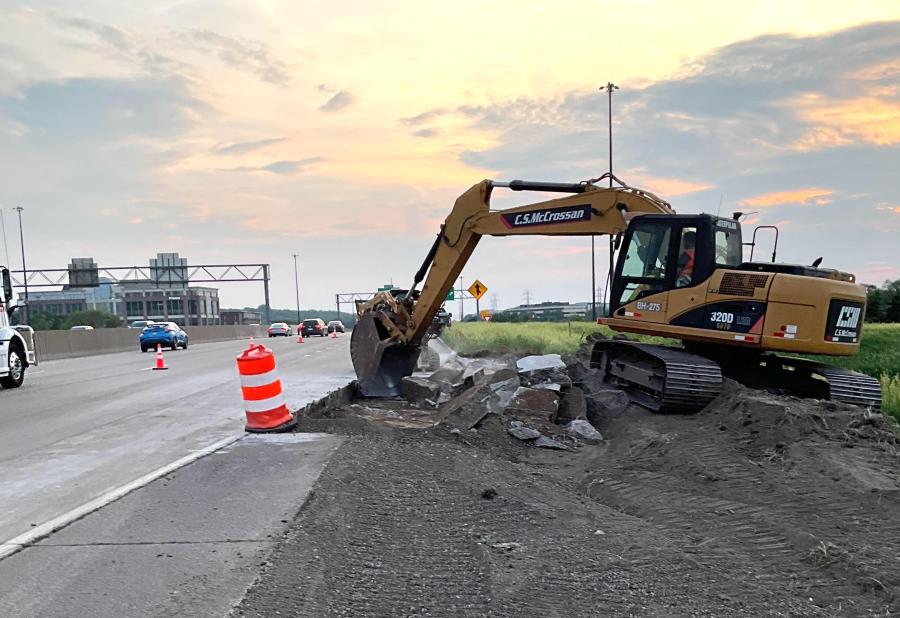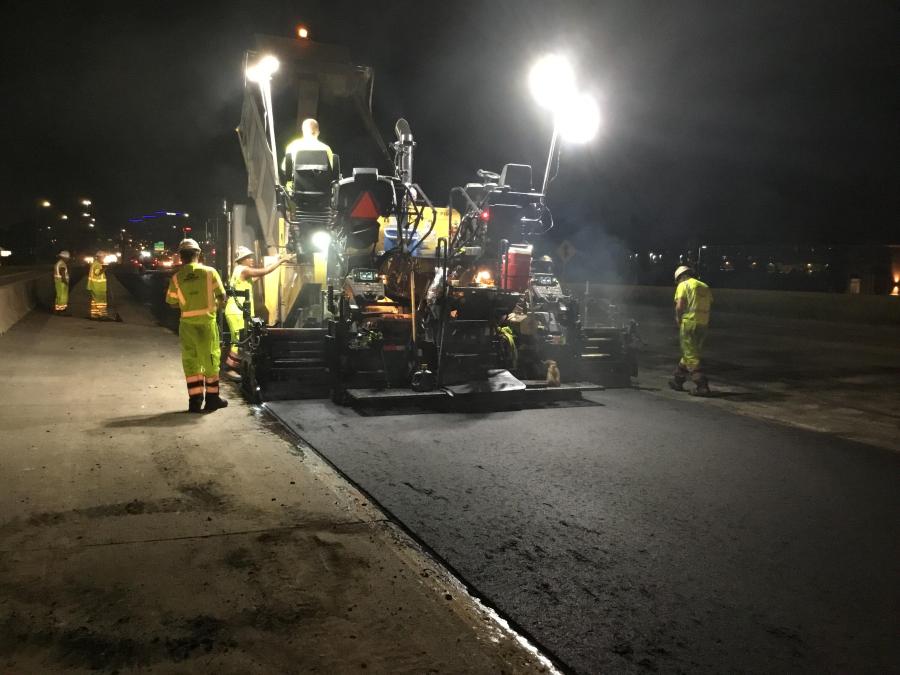The project requires approximately 1,000,000 cu. yds. of grading and excavation.
(MnDOT photo)
The Minnesota Department of Transportation (MnDOT) is overseeing the first of four construction projects tied to the I-494: Airport to Hwy 169 vision. As part of the $377 million dollar undertaking, crews are constructing E-ZPass lanes on I-494 from Hwy 100 to I-35W in each direction and adding a new ramp at the I-35W and I-494 interchange. The work extends from East Bush Lake Road in Edina to 12th Avenue in Richfield.
"I-494 sees about 130,000 vehicles per day, and I-35W sees more than 90,000 vehicles," said Tim Clyne, MnDOT construction manager of the I-494 design-build project. "The I-494 corridor serves as both a commuter route across the south metro area, as well as a major travel route to and from the Minneapolis-St. Paul International Airport and the Mall of America."
According to Clyne, E-ZPass can provide a more reliable travel option during busy weekday commuting hours.
"Outside of morning and afternoon rush hours, the E-ZPass lane is open to all traffic. The idea is to move more people through the area during busy commutes by providing a dedicated lane that's free for HOV users (and buses and motorcycles), while single occupant vehicles pay a fee."
Workers also are replacing the bridges crossing over I-494 at Portland Avenue, Nicollet Avenue and 12th Avenue, and adding a new pedestrian bridge at Chicago Avenue that crosses over I-494 to provide an additional pedestrian and bicycle connection across I-494.
The new bridges at Portland, Nicollet and 12th avenues will accommodate future traffic levels, provide wider, accessible sidewalks, new bike lanes and upgrades to some transit stations. Workers will be removing access to I-494 from Nicollet Avenue and 12th Avenue but will provide full access to I-494 from Portland Avenue.
The work includes constructing and repairing pavement on I-494 and local roads, reconfiguring the I-35W/I-494 interchange, repairing bridges at France Avenue and Penn Avenue and building noise and retaining walls. Crews also will be relocating or adjusting multiple public and private utilities, as well as replacing lighting, signage and dynamic message boards.
"Construction just started in early June with temporary widening and median crossovers to prepare for future stages of construction," said Clyne. "This project has been under development and procurement for a long time, so it's very rewarding to see construction finally coming to fruition."
Motorists can expect increased travel times and backups as they drive through the work zone. A reduced work zone speed limit will be in effect during construction. Three travel lanes will be open each direction during the day. However, there will be many weekend, nighttime and directional closures along I-494 and I-35W during the project.
Ramps and loops will be closed at various times, with detour routes posted. There also will be some lane and road closures on local roadways throughout the corridor. Business access will be provided throughout the corridor.
When work is completed in fall 2026, motorists will reportedly benefit from less congestion and safer travel along I-494 and I-35W. Drainage infrastructure will be improved, so the risk of the interstate flooding during heavy rainstorms will be lessened.
Pedestrians, bicyclists and transit riders can expect better mobility throughout the local road system, including across I-494.
Clyne noted the biggest challenge during construction will be providing a safe area for road crews and the traveling public.
"Motorists play a huge role in keeping work zones safe by slowing down, avoiding distractions behind the wheel and staying focused on the road. This is one of the busiest stretches of freeway in Minnesota, so maintaining traffic along the interstate and local roadways will also be very challenging."
In addition, there are more than 350 potential conflicts with private and public utility owners throughout the corridor.
"The design-build team is doing its best to design around many conflicts, but there will be a large number of utilities that need to be relocated prior to construction in various areas throughout the project," said Clyne.
"Also, the contractor is seeing long lead times for many materials, including steel and reinforced concrete pipe. Because this is a four-year project, many material suppliers and subcontractors are unwilling to guarantee prices out so far. The prime contractor owns a lot of risk on these prices."
Much of the early work this spring has focused on design work and the submission of various management plans and other paperwork requirements.
"The design team is hard at work developing those plans for work to be constructed this year," Clyne explained. "The contractor started temporarily widening the road and building crossovers in early June. More permanent changes to the road began in early July.
The contractor is gearing up for full-scale production by preparing two site prep/material laydown yards, creating field trailers for inspectors' offices and lab space, and setting up an aggregate crusher to process excavated material on site. To alleviate traffic throughout the highway network, crews striped an additional auxiliary lane on TH 62, a parallel east-west route that's expected to see increased traffic diverting from I-494. Removals, grading and paving of a few temporary crossovers and widening areas have been completed to date.
Regarding the Nicollet Avenue, Portland Avenue and 12th Avenue bridges, first the contractor will construct a new pedestrian bridge at Chicago Avenue in 2024 to accommodate pedestrian and bike traffic crossing I-494. The Portland Avenue bridge will be constructed in 2025, followed by the Nicollet Avenue and 12th Avenue bridges in 2026.
"For each of the three bridges, the contractor first needs to shift eastbound and westbound I-494 traffic to the outside to build the center median pier, then shift traffic to the inside to build the abutments on either side of I-494. Removals of the existing bridges and beam setting / deck pouring will require full weekend or overnight closures of I-494.
For eastbound and westbound I-494 bridges over I-35W, the contractor will add temporary widening to the westbound bridge this year, which will allow for traffic shifts while building the eastbound bridge in 2024. In 2025, the westbound bridge will be constructed while traffic travels on the new eastbound bridge.
Clyne noted these aren't the only significant changes.
"A new northbound I-35W to westbound I-494 turbine ramp is the centerpiece of this interchange. Because of the heavy traffic volumes and limited space, the interchange will be built in multiple stages. First the turbine ramp bridge over I-35W will be constructed, along with retaining walls and grading on either side.
"One lane of westbound I-494 through traffic will then be shifted onto this turbine ramp through the interchange, as well as the northbound I-35W to westbound I-494 traffic, both by temporary pavement. Much of the permanent turbine ramp can be built offline while traffic is in this temporary configuration."
Three new braid bridges will also be constructed at the interchange, featuring two at Penn Avenue and I-494 and one at 82nd Street and I-35W. These braid bridges eliminate traffic weaving over short distances, leading to better safety and reduced congestion.
During construction, workers must be mindful of the elements.
"Because of our infamous Minnesota winters, the construction season only lasts from about April to November. Cool weather in spring and fall affects the type of work and productivity of the crews. During each construction season, the contractor has 20 percent of available working days blocked off for weather contingency. This means a lot of work to be performed in a limited amount of time."
Heavy equipment on the job includes dozers; blades; backhoes; a concrete paving train; bituminous paver; rollers; cranes; and numerous trucks.
The project requires approximately 1,000,000 cu. yds. of grading and excavation; 300,000 sq. yds. of concrete paving; 80,000 tons of bituminous paving; 12 new bridges (11 with prestressed concrete beams and one steel truss pedestrian bridge); multiple retaining walls (a combination of cast-in-place concrete, MSE, gravity block); and five noise walls using precast concrete panels.
C.S. McCrossan, a family-owned, Minnesota-based heavy highway contractor, has constructed a majority of the large projects along the entire I-494 corridor over the last 20 years. Michael Baker International serves as the lead design firm. CEG
Today's top stories

















